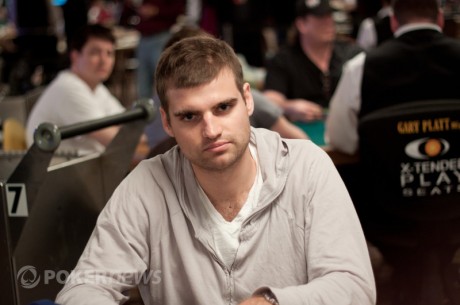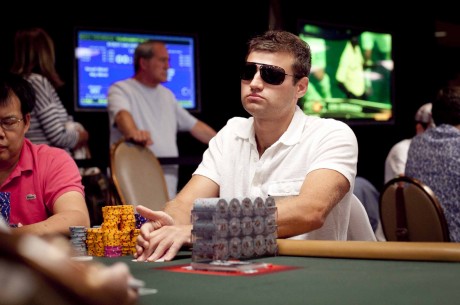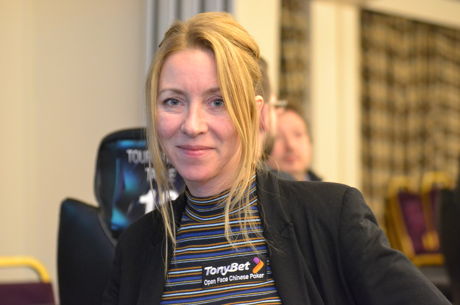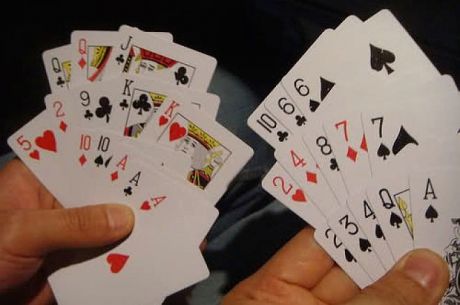Spice Up Your Open-Face Chinese Poker Game by Adding a Pineapple Twist

If you’re reading this, I assume that you’ve already played open-face Chinese poker (OFC). Perhaps you’ve even read some of my previous articles on the subject, or have heard me talk about OFC with Kristy Arnett on the Strategy with Kristy Podcast. If you’re not familiar with the rules and basic strategy of standard OFC (with fantasy land), you can read about them here.
However, with all of that OFC rah-rah and experience, pineapple OFC may be something that you’ve just heard mention of, or perhaps seen your favorite poker tweeters bragging about on the Internet. Read on, as I rush through the basics, to how pineapple strategy differs from standard OFC to some of the odds for the numbers-driven crowd.
No one knows whether the pineapple OFC variant is here to stay, and it certainly won’t be the last of the OFC variants that will become popular. It will never become the main set of rules under which OFC is played. At best, pineapple OFC is to pot-limit Omaha what standard OFC is to no-limit hold’em.
But for my money, pineapple OFC is a great game. It’s like regular OFC on steroids, keeping the same game structure, but with great hands coming in twice as often, and in half the rounds. The game can’t be spread four-handed, but it makes for great heads-up and three-way action. It’s more addictive than regular OFC and not a good choice for a game with which to end a poker night, because you’ll no doubt be playing till the wee hours.
It’s also exhausting. With more possible plays on every turn, and with more cards to account for, it’s not a game that you can play on auto-pilot. Even heads up. But enough banter, let’s start with the rules.
One Extra Card, Four Faster Rounds
The first five cards are played the same way as in regular OFC, with players placing their cards in any of the three possible rows, and 13 available spaces.

After that, players get three cards in turn, and set two cards as they wish, while discarding the third card. Thus the game is reduced to four rounds of two cards played per round, after the initial five. This differs from standard OFC, in which there are eight rounds of one card placed at a time.
It is customary to place your discarded card face-down, thus adding an awkward hidden-information element that’s absent from regular OFC. On a side note, I think that this is a bad rule, but it’s the way that the game is usually played. The game would be better if players showed all three cards and discarded the unplaced card face-up. This would make it easier to analyze and second-guess how everyone is playing. Friends who are learning the game often ask me about a play, thus revealing their discard. I don’t think this affects the game very much, and it would be more fun if this were standard. Even so, most people play with the third card discarded face-down, and I don’t expect this to change.
Same Cutoffs, but Extra Cards for Fantasy Land
The rules for qualifying for fantasy land are the same as in standard OFC: you need QxQx or better on top. Once there, you need either quads on the bottom, a full house in the middle, or trips on top to stay in fantasy land. However, the astute reader will immediately see that fantasy land should be worth much less in a game where players get extra cards and generally make much bigger hands in the course of regular play.
Thus in pineapple OFC, a player in fantasy land gets 14 cards, discards one, and plays his or her best 13-card hand. This may not seem like a huge advantage over regular Fantasyland, but it’s actually quite substantial. Skip to the numbers at the end of this piece to see the details, but for now suffice it to say that 14-card fantasy land in pineapple ends up being worth almost exactly the same as 13-card fantasy land in standard OFC.
Maybe this is an accident, but I think it’s further proof that OFC poker hit some sort of golden ratio when it was invented by those crazy Russians a couple of years back. Somehow giving the fantasy land player one extra card is exactly what it takes to maintain the balance between fantasy land value and regular hand value that makes OFC so much fun.
"The Game Done Changed." / "Game's the Same, Just Got More Fierce."
This exchange between Cutty and Slim Charles on Season 3 of The Wire just about sums it up. Pineapple OFC is really the same game as regular OFC, it’s just more fierce.
Big hands, and especially big pairs on top that take you to fantasy land, come in much more often. But many of the same strategic rules still apply.
In a previous piece on setting the first five cards in OFC, I advocate for an aggressive strategy that favors a path to big hands, which takes account of live cards, and tried to keep your starting hand flexible. All of this applies even more so for setting pineapple hands.
Some strategies do change, though.
The Triple Threat
Not only will you be seeing 50% more cards after the first five, but you’ll also get to build your hands two cards at a time. Thus, runner-runner becomes easier to catch, which favors setting flexible starting hands.

In the above example, you’re getting 50% more cards — to make either a flush, a straight, or even a full house should the Jxs and 9xs start coming. There is no better way to start a pineapple bottom hand than with a two-card straight flush. You’re almost 100% to make at least two pair, thus you can play for fantasy land right away. You’re also one good draw away from having a 15-point bonus draw waiting for you on the bottom. Of course, once you’ve placed that third card on the bottom and chosen a path, the other options fade to black.
Playing the A♠ on top here is actually against the norm. It usually goes in the middle, but with this hand in particular, there’s no other way to play for more balance and flexibility. It’s a good hand no matter what comes.

My hand has flexibility, and I keep that flexibility by not committing the bottom hand to a flush draw. Instead I use the K♦6♣2♦ draw I received to make a pair in the middle, and to give myself more fantasy land possibilities up top.

I’m immediately rewarded with a live straight-flush draw, unless, of course, my sneaky silicon opponent threw away that 10♣ without me knowing. Note that he’s working on a straight-flush draw of his own.
The next pull doesn’t get me there, but it does give me two pair in the middle, making the fantasy land draw a real possibility for a consolation prize. In other words, my hand is very live.

Boom! My straight flush hits even though the fantasy land draw misses.
Not all pineapple hands are as exciting at this one, but these kinds of draws are far more common than in regular OFC. In fact, this was the very first hand that I logged against the (still in Alpha) upcoming , when starting my marathon match in preparation for this article.

"In Order to Live, You Must Be Willing to Die."
Those are the words of the late, great Amir Vahedi, who was saying that you’ve got to take risks if you want to win in poker. Pineapple OFC explicitly challenges you to make big hands. If you don’t, you’ll be barbecued by the more experienced and risk-minded players (I’m sorry Ryan Miller, your slow and steady approach won’t work here).
It’s generally much harder to foul in pineapple, to the point where I rarely worry about fouling a hand early. Some of this is obvious. There’s a 100% chance that you can make a small pair or better in the middle, so you can always safely play face cards on top, which you’ll need to do if you want to have a chance at fantasy land. Other gambles are less obvious and would seem downright foolhardy to the seasoned OFC player just learning pineapple.

In this hand, I started with a pretty solid hand but my opponent has a better one, that is until I immediately get a 9♦A♥9♣ draw. Could I…. no I couldn’t… but really, could I?

I absolutely must play the trip nines in the middle. Why take all that risk? Well, what is my alternative? My opponent has a really good hand. He’s close to 100% to find a second pair (or a live 8x) for his bottom hand, at which point I’ll need to beat his two-pair or 8x8x8x bottom and his AxAx middle in order to avoid getting scooped by a very big hand.
Obviously I’ll need either three spades or two tens to qualify on the bottom, but again, what is my alternative? To play one pair of nines? To put a dead Ax up top as my kicker? No chance.

Two draws later, I’m running out of luck. I haven’t improved my upside by making QxQx or KxKx up top, so even if I make this hand, it won’t necessarily pay big. I also have a choice with the 10♥4♦2♣ — do I hope for another 10x or two spades on the bottom?
This isn’t a math article, so I won’t pretend that I calculated the odds. I chose to root for the 10x, and to keep an outside chance at fantasy land.

On the last draw, I caught the 10x, but I missed my fantasy land draw while my silicon friend made his. Even so, the 9x9x9x in the middle was a good move. Look at what I was up against. I needed to take that chance and to try to win a spot against a very good hand.
These kinds of situations come up in pineapple quite often. Try to keep your hand flexible. Put a Kx or Qx up top so you can hit a couple of luck cards and go to fantasy land. Don’t be afraid to take risks. You’ll foul less often than regular OFC conditioning leads you to think, and you’ll often be rewarded.
Odds for the Numbers Nerds
In the process of writing this article, I played a 230-hand pineapple OFC match against the computer on my ABC OFC iPhone app. The computer engine uses the same AI that played me within 1/4 point per hand in regular OFC over a long match, with no retraining applied. Thus, the fact that I beat if for +1.8 pt/hand over 230 pineapple hands isn’t that interesting.
What is interesting are some of the side-effect statistics that I collected. Here are the results, in short form below:
- I qualified for fantasy land on 25% of attempts (44/177), while fouling 28% of the time to get there (50/177).
- With the 14-discard-1 fantasy land rule, I stayed in fantasy land on 15% of attempts (8/44), while the CPU stayed on 14% of its attempts (4/25).
- The net value of fantasy land (including cumulative scores for any “stay” hands) was +13.0 pts/hand for me, and +13.8 pts/hand for the computer.
The sample wasn’t huge, but the numbers stabilized very quickly. I’m amazed by the natural summary of the game. We’ve changed several rules for pineapple OFC, some arbitrarily, and yet fantasy land is still worth +13 points.
What’s changed though is that now it’s possible to maintain a foul-to-fantasy land ration that very close to 1:1, while making a large number of fantasy land hands. In regular OFC, I fouled over 30% of my hands to get to Fantasyland on 7.5% of attempts. In pineapple, that kind of risk pays off much more handsomely.
Please comment, or seek me out on Twitter , if you have further interest in these numbers, or if you have equations and derivations to show me about (which I’m very unlikely to understand).
OFC rules have been contributed by Nikolai Yakovenko. Known as "Googles,"Yakovenko is originally from Moscow, Russia and is now a poker player and software developer that resides in Brooklyn, New York. After several years at Google New York working on ranking algorithms, he's been developing independent software projects ever since. On his poker record, Yakovenko has made both World Series of Poker and World Poker Tour final tables. He also helped create , which is where the sceenshots are from. The Pineapple version of the app is currently in beta, but will be available to the public soon. You can follow Yakovenko on Twittter at .
Get all the latest PokerNews updates on your social media outlets. on Twitter and find us on both and !








